 |




















|
 |
 |
|
author:
|
Asset Teacher Enhancement Program
|
|
submitter:
|
Asset Teacher Enhancement Program
|
|
description:
|
We will highlight one of our approaches to performance-based assessment of our elementary science program to provide a starting point for discussion.
Presented at the National Science Foundation Local Systemic Change Projects Principal Investigator Annual Meeting, January 21-23, 1999.
|
|
presented at:
|
National Science Foudnation Local Systemic Change Projects Principal Investigator Annual Meeting
|
|
published:
|
02/11/1999
|
|
posted to site:
|
02/11/1999
|
Overview of Assessment Framework
PI Conference
Washington D.C. - January 22, 1999
ASSET, Inc.
290 Corliss Street
Pittsburgh, PA 15220
Phone (412) 771-2121
FAX (412) 771-5130
Presenters: Reeny Davison, Vince Valicenti, Linda Boord
IDENTIFYING AND ASSESSING ENDURING LESSONS
At the ASSET Leadership Conference, grade level teams of building lead teachers identified two enduring learnings from each module they teach. They also identified the products that could be used to assess how well their students had attained these learnings.
This information will be used as the basis for the continuing development of the ASSET Performance Assessment Program. For the past two years, we have attempted to complete a science assessment blueprint for every lesson in a module that required the students to perform a task or complete a product. For some modules this meant writing seven, eight, or even nine rubrics and blueprints. This was proving to be overwhelming and unnecessary.
Thanks to the efforts of the building lead teachers we can now focus on developing two blueprints per module. This provides us with a more realistic approach to the performance based assessment process, but still enable us to assess the most important concepts, processes, and skills of each module. Quality rubrics can be developed for the essential processes and skills that are taught without the overwhelming prospect of administering 8 or 9 performance assessments for each module.
This approach to the assessment process makes it feasible to complete a framework for the two enduring lessons for each STC module by the beginning of the 1999-2000 school year. The framework for each module will include:
- A statement of the enduring learnings.
- A listing of the products to be assessed.
- The science assessment blueprint to be used.
- Samples of student work that represent the highest level of desired performance.
A completed framework for at least one of the modules for each grade level is enclosed. To complete the framework concept, we need to:
- Collect samples of student work for each of the identified enduring learnings.
- Complete the two blueprints for each module.
- Field test assessment rubrics that are included in the blueprints.
- Make any revisions to the process that are necessary.
- Institutionalize the assessment process.
This is still a huge undertaking, but one that seems achievable within the next two years. We will continue to need your help to make it happen.
ASSET PERFORMANCE ASSESSMENT FRAMEWORK FOR FIRST GRADE
| ENDURING LEARNING |
PRODUCT TO BE ASSESSED |
BLUEPRINT |
SAMPLE |
|
WEATHER |
|
|
| 1. Using simple tools of measurement |
temperature records from lessons 5-A, 7-A, 7-B, & 8-A |
X |
X |
| 2. Drawing Conclusions from an activity or experiment |
Data record sheets from lessons 9-A & 12-A |
X |
X |
|
ORGANISMS |
|
|
| 1. Recording observations in words and drawings and applying what was observed |
Drawings of living things from lessons 4-A, 5-A, 7-A, & 9-A |
X |
X |
| 2. Understanding organisms have basic needs |
Venn diagram from lesson 16 & Post Unit Assessment #1 |
X |
X |
|
COMPARING AND MEASURING |
|
|
| 1. Comparing the height and length of objects. |
Measurement records of height and length of objects from lessons 3, 4, 5, & 6 |
|
|
| 2. Using standards of measurement. |
Measurement records from lessons 8-A, 11-A, 14-A, & 16-A |
|
|
|
SOLIDS AND LIQUIDS |
|
|
| 1. Observing and describing properties of solids. |
Venn diagrams and record sheets from lessons 3-A, 7-A, & 9-A |
|
|
| 2. Observing and describing properties of liquids. |
Venn diagrams and record sheets from lessons 12-A, 13-A, 14-A, 15-A, & 16-A. |
|
|
ENDURING LEARNINGS
The two "enduring learnings" that have been identified for each module were selected by teachers who have taught the modules. They are the two skills or concepts that the teachers felt were worth knowing and that we should assess to determine if our students attained them.
These two enduring learnings are emphasized in the module. Two or more activities are related to them. The students will complete at least two products that can be used to evaluate their understandings of these learnings.
All of the enduring learnings are correlated to the state or national science standards.
ASSET PERFORMANCE ASSESSMENT FRAMEWORK
FIRST GRADE
| ENDURING LEARNING |
PRODUCT TO BE ASSESSED |
BLUEPRINT |
SAMPLE |
| |
WEATHER |
|
|
| 1. Using simple tool such as the thermometer. |
Temperature records from Lessons 5-A, 7-A, 7-B, & 8-A |
X |
X |
| 2. Drawing conclusions from an activity or experiment. |
Data Record Sheets from lessons 9-A and 12-A |
X |
X |
STC Unit: Weather
Grade Level: 1
Enduring Learning: Using Simple Tools of Measurement-The Thermometer
| Criteria |
Reading a Thermometer |
Relationship Between Temperature and Weather and Behavior |
| Weight |
% |
% |
| 3 |
Read and recorded the temperature of the thermometer accurately for all four
activities or progressed to reading the temperature accurately by the fourth
activity. |
Correctly articulated the relationship between the temperature and the
type of weather all of the time. |
| 2 |
Read and recorded the temperature of the
thermometer accurately for a majority of the activities. |
Correctly articulated the
relationship between the temperature and the type of weather some of the
time. |
| 1 |
Read and recorded the temperature of the thermometer inaccurately
most or all of the time. |
Cannot articulate the relationship between the weather
and the temperature. |
| 0 |
Makes no attempt to do this activity. |
Makes no attempt to do this activity. |
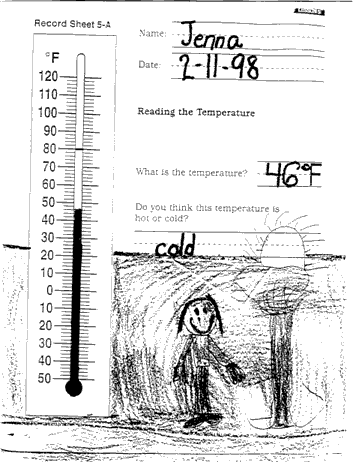
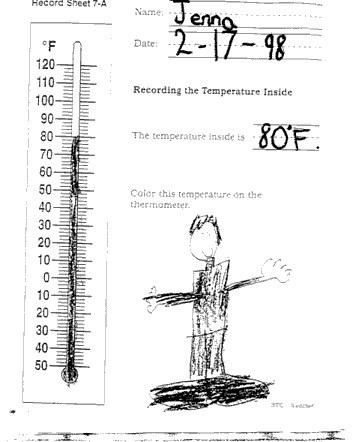
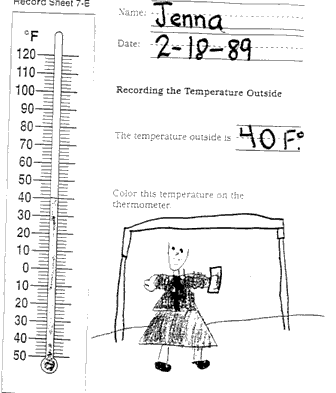
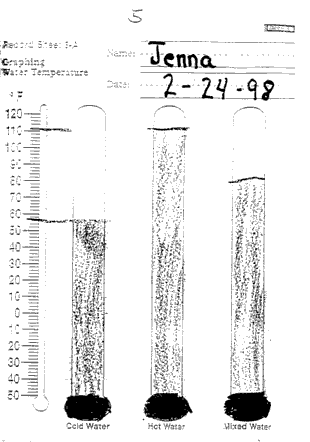
STC Unit: Weather
Grade Level: 1
Enduring Learning: Drawing Conclusions About an Experiment
| Criteria |
Observe and Record Results |
Drawing Conclusions |
Conducting the Experiment |
| Weight |
% |
% |
% |
| 3 |
Accurately draws and records the results without assistance. |
Draws logical
conclusions based on the data obtained from the activity. |
Follows directions
exactly, works neatly and carefully, and results well organized. |
| 2 |
Accurately
draws and records the results, but needs some assistance. |
Conclusions reflect some
understanding of the activity, but not totally related to the data. |
Follows some
of the directions, work is legible and somewhat organized. |
| 1 |
Drawing and
recording does not reflect what occurred during the activity. |
Makes an attempt to
respond, but unable to draw a conclusion based on the data. |
Unable to follow
directions, work is sloppy and hard to read and very disorganized. |
| 0 |
Makes no
attempt. |
Makes no attempt. |
Makes no attempt. |
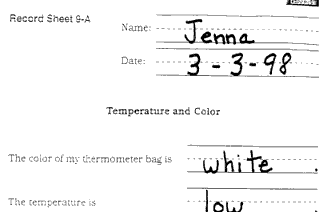
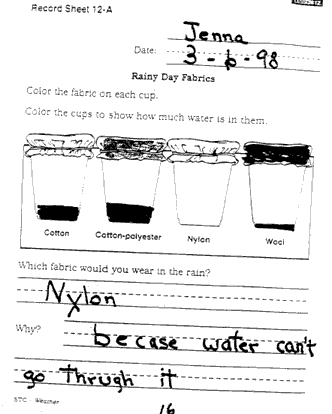
ENDURING LEARNINGS
The two "enduring learnings" that have been identified for each module were selected by teachers who have taught the modules. They are the two skills or concepts that the teachers felt were worth knowing and that we should assess to determine if our students attained them.
These two enduring learnings are emphasized in the module. Two or more activities are related to them. The students will complete at least two products that can be used to evaluate their understandings of these learnings.
All of the enduring learnings are correlated to the state or national science standards.
ASSET PERFORMANCE ASSESSMENT FRAMEWORK
FIRST GRADE
| ENDURING LEARNING |
PRODUCT TO BE ASSESSED |
BLUEPRINT |
SAMPLE |
| |
ORGANISMS |
|
|
| 1. Recording observations in words and drawings and applying what was
observed. |
Drawings of living things from lessons 4-A, 5-A, 7-A, and 9-A. |
X |
X |
| 2. Understanding organisms have basic needs. |
Venn diagram from lesson 16 and Post Unit Assessment. |
X |
X |
STC Unit: Organisms
Grade Level: 1
Enduring Learning: Recording Observations in Words and Drawings
| Criteria |
Records Data Through Illustrations |
Records Data Through Writing |
Follows Directions |
| Weight |
% |
% |
% |
| 3 |
Illustrations are highly detailed and include special features of the living
thing. |
Written descriptions include at least 3 details that are accurate.
Attempts sentences. |
Follows directions completely. |
| 2 |
Illustrations include
some details and the living things are recognizable. |
Written descriptions contain
minimal details, some innaccuracies exists. |
Follows some of the directions. |
| 1 |
Attempt is made to draw the living thing, but no details are
recognizable. |
Written descriptions make no sense and are not accurate at all. |
Does not follow the directions at all. |
| 0 |
Makes no attempt. |
Makes no attempt. |
Makes no attempt. |
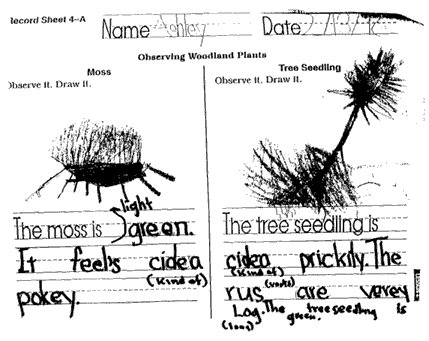
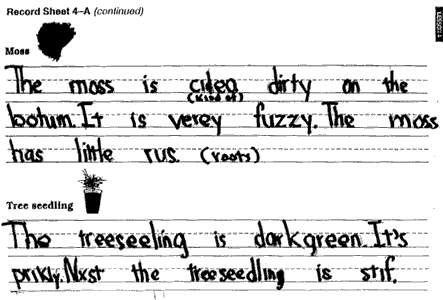
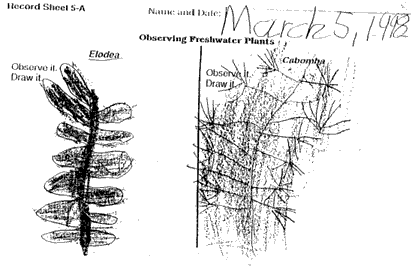
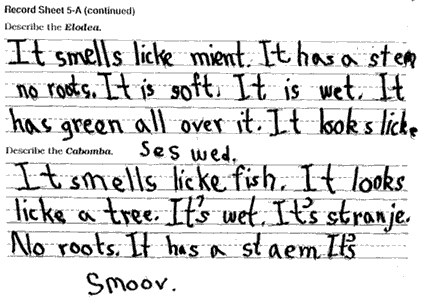
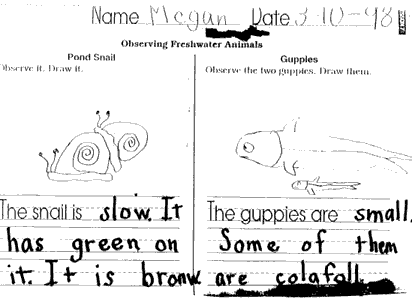
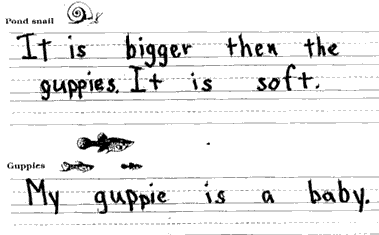
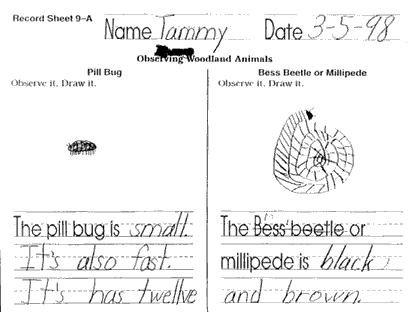
|














